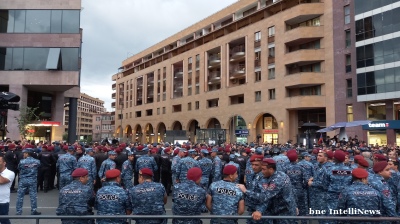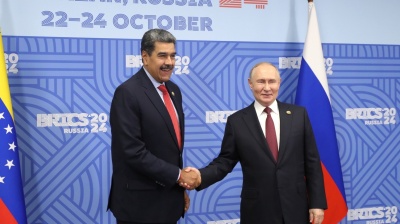Ukraine facing a financial cliff as IMF warns Ukraine may need an extra $20bn of external funding in 2025

ED - This article is part of a series looking at the affordability of increasing European defence spending and funding the war in Ukraine.
See the accompanying articles:
LONG READ: Europe can’t afford the Ukraine war
LONG READ: Europeans face recession, financial crises, as they struggle to boost defence spending
The International Monetary Fund (IMF) has concluded that Ukraine’s financing needs for 2026 and 2027 could be as much as $20bn higher than the government in Kyiv’s own estimates, as negotiations begin on securing a new aid package.
“Ukraine faces a financial cliff in 2025,” says Timothy Ash, the senior sovereign strategist at BlueBay Asset Management in London.
The International Monetary Fund admits its $15bn Extended Fund Facility (EFF) for Ukraine is underfunded by as much as $20bn through the first quarter of 2027. At the same time, EU foreign affairs chief Kaja Kallas has predicted the war in Ukraine will drag on for at least another two to three years.
“Ukrainian MOF [Ministry of Finance] being more realistic than the IMF saying the IMF programme is underfunded to the tune of $37.5bn, compared to the $10-20bn shortfall assumed by the Fund,” Ash said in a social media post. “Suffice to say the Fund programme is struggling now and hard to see sufficient financing assurances being received without resort to using immobilised CBR assets.”
The discrepancy emerged during meetings held in Kyiv over the past week between IMF staff and Ukrainian officials, Bloomberg reported on September 12, citing people familiar with the discussions. Reconciling the figures is a prerequisite before the Washington-based lender can consider Ukraine’s request for a new loan programme once its current support runs out.
The gap could in fact be even larger. “The hole in Ukraine funding is actually much higher than this – this is just budget and balance of payment financing, and I think it only assumes a one-year push out of the end of the war. If you include military as well as BOP/budget financing needs the funding requirements are $100bn plus in war, perhaps half that in peace. But as is the EU €50bn MFA and $50bn ERA are nearing exhaustion,” says Ash.
The government estimates it will require up to $37.5bn over the next two years. “If the IMF’s estimates prove correct, Kyiv may face the need to secure additional billions of dollars a year in financial support from western allies as the country seeks to sustain its fight against Russia,” Ash said.
No timeline has been set for reaching an agreement, but both sides aim to settle on a figure next week as consultations continue. Once a number is agreed, the government and the IMF are expected to engage with Ukraine’s western partners on securing additional funds.
Most of the $15.5bn IMF programme approved in 2023 has already been disbursed. The package, which runs until 2027, was based on the assumption that the war would end this year. Prime Minister Yuliia Svyrydenko is seeking approval for a new arrangement from the IMF’s executive board by the end of 2025.
The IMF remains one of Ukraine’s largest creditors, but its support is tied to policy conditions. Among them are recommendations to raise fiscal revenues. Ukraine has resisted increasing taxes on its population, citing wartime hardship, but the IMF is expected to press the government to clamp down on the shadow economy, which the cabinet estimates accounts for more than 30% of GDP.
Ash argues that with a huge hole in the budget funding and money tight and Europe can’t afford to take over the burden of supporting Ukraine, as most EU countries are either in recession or approaching a crisis the time has come to seize Russia’s frozen $300bn of Central Bank of Russia (CBR) assets as the only source of cash available.
“Europe is realising that the only way to fund Ukraine to survive the war is to fully utilise the $330bn in immobilised CBR assets sitting, largely dormant, in Western bank accounts,” Ash said. “Given Europe’s fiscal woes, it’s hard to see national governments stumping up much more money for Ukraine, hence the realisation that CBR assets have to be utilised… In the end, the harsh reality for Europe is that if CBR assets are not going to be used, how do you propose to fund the $100 billion a year cost of keeping Ukraine in the war, and your frontline against Russian aggression and expansion against/to Europe?”
Opinion

COMMENT: Czechia economy powering ahead, Hungary’s economy stalls
Early third-quarter GDP figures from Central Europe point to a growing divergence between the region’s two largest economies outside Poland, with Czechia accelerating its recovery while Hungary continues to struggle.

COMMENT: EU's LNG import ban won’t break Russia, but it will render the sector’s further growth fiendishly hard
The European Union’s nineteenth sanctions package against Russia marks a pivotal escalation in the bloc’s energy strategy, which will impose a comprehensive ban on Russian LNG imports beginning January 1, 2027.

Western Balkan countries become emerging players in Europe’s defence efforts
The Western Balkans could play an increasingly important role in strengthening Europe’s security architecture, says a new report from the Carnegie Europe think-tank.

COMMENT: Sanctions on Rosneft and Lukoil are symbolic and won’t stop its oil exports
The Trump administration’s sanctions on Russian oil giants Rosneft and Lukoil, announced on October 22, may appear decisive at first glance, but they are not going to make a material difference to Russia’s export of oil, says Sergey Vakulenko.



